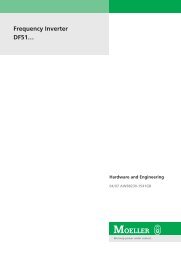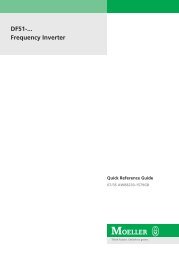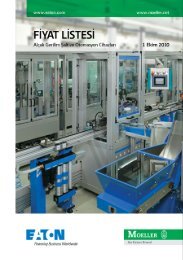Hardware and Engineering DF6-340-... Frequency ... - Moeller.com.tr
Hardware and Engineering DF6-340-... Frequency ... - Moeller.com.tr
Hardware and Engineering DF6-340-... Frequency ... - Moeller.com.tr
Create successful ePaper yourself
Turn your PDF publications into a flip-book with our unique Google optimized e-Paper software.
01/02 AWB8230-1413GB PID con<strong>tr</strong>olThe example in the following figure shows a fan con<strong>tr</strong>ol system:wG1Figure 116: Example of a fan con<strong>tr</strong>ol systemG1:<s<strong>tr</strong>ong>DF6</s<strong>tr</strong>ong> frequency inverterw: Setpointx: Actual valueP1: Con<strong>tr</strong>olled variableB1: Measured value convertera FanP: Proportional <s<strong>tr</strong>ong>com</s<strong>tr</strong>ong>ponentThis <s<strong>tr</strong>ong>com</s<strong>tr</strong>ong>ponent ensures that the output frequency <s<strong>tr</strong>ong>and</s<strong>tr</strong>ong> the systemdeviation are proportional to each other. Using PNU A072, youcan define the proportional gain K p in %.The following figure illus<strong>tr</strong>ates the relationship between systemdeviation <s<strong>tr</strong>ong>and</s<strong>tr</strong>ong> output frequency. A large value of K p results in aquick response to a change of the system deviation. If, however,K p is too large, the system be<s<strong>tr</strong>ong>com</s<strong>tr</strong>ong>es unstable.f[%]100755025M3~xB10... +10 V H ; 4 – 20 mAKp = 2aP1Kp = 1Kp = 0.75Kp = 0.5Kp = 0.250.2 F Kp F 0.5The maximum output frequency in figure 117 is defined as 100 %.With PNU A072, you can set K p between 0.2 <s<strong>tr</strong>ong>and</s<strong>tr</strong>ong> 5.0.I: Integral <s<strong>tr</strong>ong>com</s<strong>tr</strong>ong>ponentThis <s<strong>tr</strong>ong>com</s<strong>tr</strong>ong>ponent results in a correction of the output frequency byintegration of the system deviation. With purely proportionalcon<strong>tr</strong>ol, a large con<strong>tr</strong>ol deviation results in an equally large changein the output frequency; If, therefore, the con<strong>tr</strong>ol deviation is verysmall, the change in the output frequency is also small. Theproblem is that the system deviation cannot be <s<strong>tr</strong>ong>com</s<strong>tr</strong>ong>pletelyeliminated. Hence the need for an integral <s<strong>tr</strong>ong>com</s<strong>tr</strong>ong>ponent.The integral <s<strong>tr</strong>ong>com</s<strong>tr</strong>ong>ponent causes a continuous adding up of thesystem deviation so that the deviation can be reduced to zero. Thereciprocal value of the integration gain is the integration timeT i =1/K i .For the <s<strong>tr</strong>ong>DF6</s<strong>tr</strong>ong> frequency inverters, set the integration time (T i ). Thevalue may be between 0.5 <s<strong>tr</strong>ong>and</s<strong>tr</strong>ong> 3600 s. To disable the integral<s<strong>tr</strong>ong>com</s<strong>tr</strong>ong>ponent, enter 0.0.D: Differential <s<strong>tr</strong>ong>com</s<strong>tr</strong>ong>ponentThis <s<strong>tr</strong>ong>com</s<strong>tr</strong>ong>ponent causes a differentiation of the system deviation.Because pure proportional con<strong>tr</strong>ol uses the current value of thesystem deviation <s<strong>tr</strong>ong>and</s<strong>tr</strong>ong> pure integral con<strong>tr</strong>ol the values fromprevious actions, a certain delay in the con<strong>tr</strong>ol process alwaysoccurs. The D <s<strong>tr</strong>ong>com</s<strong>tr</strong>ong>ponent <s<strong>tr</strong>ong>com</s<strong>tr</strong>ong>pensates for this behaviour.Differential con<strong>tr</strong>ol corrects the output frequency using the rate ofchange of the system deviation. The output frequency cantherefore be <s<strong>tr</strong>ong>com</s<strong>tr</strong>ong>pensated very quickly.You can set K d between 0 <s<strong>tr</strong>ong>and</s<strong>tr</strong>ong> 100 s.PID con<strong>tr</strong>olPID con<strong>tr</strong>ol <s<strong>tr</strong>ong>com</s<strong>tr</strong>ong>bines the P, I <s<strong>tr</strong>ong>and</s<strong>tr</strong>ong> D <s<strong>tr</strong>ong>com</s<strong>tr</strong>ong>ponents described in theprevious sections. In order to achieve the optimum con<strong>tr</strong>olcharacteristics, each of the three PID parameters must be set.Uniform con<strong>tr</strong>ol behaviour without large steps in the outputfrequency is guaranteed by the proportional <s<strong>tr</strong>ong>com</s<strong>tr</strong>ong>ponent; theintegral <s<strong>tr</strong>ong>com</s<strong>tr</strong>ong>ponent minimizes the existing system deviation thesteady-state <s<strong>tr</strong>ong>and</s<strong>tr</strong>ong> the differential <s<strong>tr</strong>ong>com</s<strong>tr</strong>ong>ponent ensures a quickresponse to a rapidly changing actual value signal.As differential con<strong>tr</strong>ol is based on the differentiation of the systemdeviation, it is very sensitive <s<strong>tr</strong>ong>and</s<strong>tr</strong>ong> also responds to unwantedsignals – such as interference – which can result in systeminstability. Differential con<strong>tr</strong>ol is normally not required for flow,pressure <s<strong>tr</strong>ong>and</s<strong>tr</strong>ong> temperature con<strong>tr</strong>ol.02550 75100x [%]Figure 117: Proportional gain K px: System deviation117







